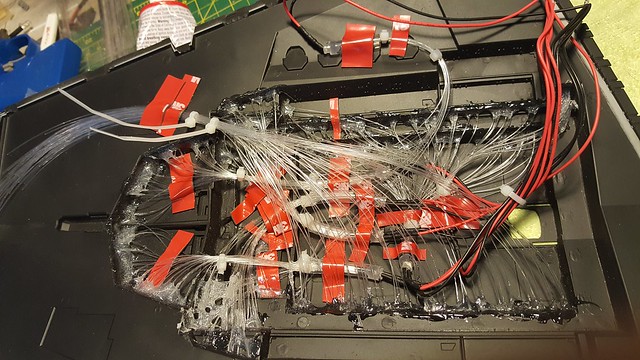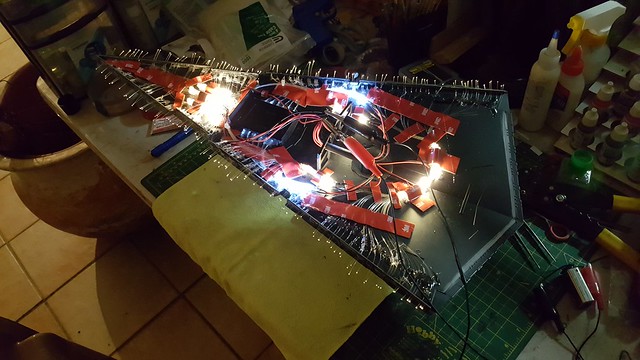You are using an out of date browser. It may not display this or other websites correctly.
You should upgrade or use an alternative browser.
You should upgrade or use an alternative browser.
Fiber optic help
- Thread starter Bergquist
- Start date
I had sanded the LED's flat and drilled into them. I had also put a styrene sleeve over it and then filled it with epoxy. I used the heat shrink as well when it was all done to contain the light. The trick here is to not drill too deep into the LED. If you touch the metal in the LED, it's done.
Keep plastic modeling glue away from the fibers. They become VERY brittle and will break at the slightest movement. If it passes any area where you'll be applying glue, put small heat shrink tubing around it (don't heat it) and then glue.
Keep plastic modeling glue away from the fibers. They become VERY brittle and will break at the slightest movement. If it passes any area where you'll be applying glue, put small heat shrink tubing around it (don't heat it) and then glue.
Bergquist
Member
Thanks guys for good advice. I learned about the effects of superglue a little too late... I have already superglued 10 fibers, and two of them snapped right off! Guess I have to drill up the holes and start over..
Do you secure the fibers with epoxy then?
Sent from my iPhone using Tapatalk
Do you secure the fibers with epoxy then?
Sent from my iPhone using Tapatalk
Darth Humorous
Well-Known Member
What about something like canopy cement/glue or Watch Crystal Cement (Micro Mart product)?
Mark
Mark
Scarecrow Joe
Sr Member
Im using Shoe Goo with great results so far.
 20170222_181838 by Oscar Baez Soria, on Flickr
20170222_181838 by Oscar Baez Soria, on Flickr
 20170210_185831 by Oscar Baez Soria, on Flickr
20170210_185831 by Oscar Baez Soria, on Flickr
 20170222_181838 by Oscar Baez Soria, on Flickr
20170222_181838 by Oscar Baez Soria, on Flickr 20170210_185831 by Oscar Baez Soria, on Flickr
20170210_185831 by Oscar Baez Soria, on Flickrevanthx
New Member
I have been reading the forums and trying several techniques with fiberoptic strands and thought I'd just add to this thread to pass along something that ended up working well for me.This started when I read somewhere about using a heatgun to ball up the end of a fiberoptic strand a bit, which helps make a slightly larger glowing ball.
I had to get some fiberoptics to make a right angle turn and hug the wall closely - and since it was open then I had to tape them down or something to make them stay. Glue and tape wasn't working well. So in the end after much experimentation I made a jig, a bit of plastic the same thickness as what I was using with about six holes in it the same size as my strands (and the same size as the hole in my actual prop.)
I fed six wires through, bent them and held them in place, and waved a heat gun over them - and the right angle bend stayed, and I now had shaped strands. (I looked up the properties of my strands and they could take a pretty good bend - and testing them showed no diminished light.) I then clipped the outside part of the strand so just a bit extended outside the wall, and hit those with the heat gun (the jig let me do six at a time without having to worry about damaging the prop.) That made the outside melt and ball up a bit.
So here was the cool part. That ball was too large to fit through the hole! I didn't have to actually glue it! I can still pull it out - get a fingernail under it our push it a bit from the inside and you can pull it out - but it can't get pulled inside the hole.
I was still left trying to attach them to the light source I had which was flat and so no glueing or heat shrink tubing seemed like it would help. So I glued a bit of a plastic drinking straw over the light source. I put heat shrink tubing over the fiberoptic ends - that shrank, and the ends of the tubes did ball a bit again, so they aren't sliding out of the heat shrink tube - and then just slid that little package inside the straw and it's now nicely held in place over the light.
It worked well!
I had to get some fiberoptics to make a right angle turn and hug the wall closely - and since it was open then I had to tape them down or something to make them stay. Glue and tape wasn't working well. So in the end after much experimentation I made a jig, a bit of plastic the same thickness as what I was using with about six holes in it the same size as my strands (and the same size as the hole in my actual prop.)
I fed six wires through, bent them and held them in place, and waved a heat gun over them - and the right angle bend stayed, and I now had shaped strands. (I looked up the properties of my strands and they could take a pretty good bend - and testing them showed no diminished light.) I then clipped the outside part of the strand so just a bit extended outside the wall, and hit those with the heat gun (the jig let me do six at a time without having to worry about damaging the prop.) That made the outside melt and ball up a bit.
So here was the cool part. That ball was too large to fit through the hole! I didn't have to actually glue it! I can still pull it out - get a fingernail under it our push it a bit from the inside and you can pull it out - but it can't get pulled inside the hole.
I was still left trying to attach them to the light source I had which was flat and so no glueing or heat shrink tubing seemed like it would help. So I glued a bit of a plastic drinking straw over the light source. I put heat shrink tubing over the fiberoptic ends - that shrank, and the ends of the tubes did ball a bit again, so they aren't sliding out of the heat shrink tube - and then just slid that little package inside the straw and it's now nicely held in place over the light.
It worked well!
Great_Bizarro
Sr Member
Try hot glue. Most solvent based glues ans epoxy types will cause the fibers to become brittle.
The Tyridium Models lighting kit for my 1/144 Falcon used shrink wrap on the cockpit fibres. I've made it more secure at the LED end and fixed the fibres in place with big blobs of PVA, which I think is one commonly used glue. Worked great. I reckon the shoe goo would be more robust, though, but I've not tried that! I'm very keen to get the LED wires in a permanent position to avoid any unnecessary strain that might make them pop out of their homes. However, PVA is extremely easy to work with and clean up so it has its plusses.
If I was doing my own, I would work in sub-assemblies I could connect and disconnect using two prong connectors. The Tyridium kit does that and it means you can secure everything except your power wires to each subassembly to avoid unseating anything. My gut is that's as important as using the very best glue.
If I was doing my own, I would work in sub-assemblies I could connect and disconnect using two prong connectors. The Tyridium kit does that and it means you can secure everything except your power wires to each subassembly to avoid unseating anything. My gut is that's as important as using the very best glue.
Scarecrow Joe
Sr Member
Try hot glue. Most solvent based glues ans epoxy types will cause the fibers to become brittle.
NO! Do not use hot glue!! Specially if you are dealing with small diameter fibers around 0.5mm or less. The heat will deform them or melt them through. Talking from hands on experience. I glued mine with Shoe Goo on the Zvezda Star Destroyer build.
Similar threads
- Replies
- 19
- Views
- 2,149

